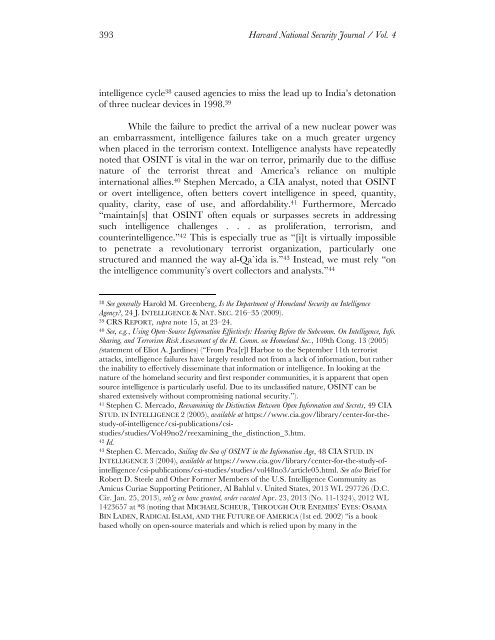Vo.4-Moshirnia-Final
Vo.4-Moshirnia-Final
Vo.4-Moshirnia-Final
Create successful ePaper yourself
Turn your PDF publications into a flip-book with our unique Google optimized e-Paper software.
393 Harvard National Security Journal / Vol. 4<br />
intelligence cycle 38 caused agencies to miss the lead up to India’s detonation<br />
of three nuclear devices in 1998. 39<br />
While the failure to predict the arrival of a new nuclear power was<br />
an embarrassment, intelligence failures take on a much greater urgency<br />
when placed in the terrorism context. Intelligence analysts have repeatedly<br />
noted that OSINT is vital in the war on terror, primarily due to the diffuse<br />
nature of the terrorist threat and America’s reliance on multiple<br />
international allies. 40 Stephen Mercado, a CIA analyst, noted that OSINT<br />
or overt intelligence, often betters covert intelligence in speed, quantity,<br />
quality, clarity, ease of use, and affordability. 41 Furthermore, Mercado<br />
“maintain[s] that OSINT often equals or surpasses secrets in addressing<br />
such intelligence challenges . . . as proliferation, terrorism, and<br />
counterintelligence.” 42 This is especially true as “[i]t is virtually impossible<br />
to penetrate a revolutionary terrorist organization, particularly one<br />
structured and manned the way al-Qa`ida is.” 43 Instead, we must rely “on<br />
the intelligence community’s overt collectors and analysts.” 44<br />
38 See generally Harold M. Greenberg, Is the Department of Homeland Security an Intelligence<br />
Agency?, 24 J. INTELLIGENCE & NAT. SEC. 216–35 (2009).<br />
39 CRS REPORT, supra note 15, at 23–24.<br />
40 See, e.g., Using Open-Source Information Effectively: Hearing Before the Subcomm. On Intelligence, Info.<br />
Sharing, and Terrorism Risk Assessment of the H. Comm. on Homeland Sec., 109th Cong. 13 (2005)<br />
(statement of Eliot A. Jardines) (“From Pea[r]l Harbor to the September 11th terrorist<br />
attacks, intelligence failures have largely resulted not from a lack of information, but rather<br />
the inability to effectively disseminate that information or intelligence. In looking at the<br />
nature of the homeland security and first responder communities, it is apparent that open<br />
source intelligence is particularly useful. Due to its unclassified nature, OSINT can be<br />
shared extensively without compromising national security.”).<br />
41 Stephen C. Mercado, Reexamining the Distinction Between Open Information and Secrets, 49 CIA<br />
STUD. IN INTELLIGENCE 2 (2005), available at https://www.cia.gov/library/center-for-thestudy-of-intelligence/csi-publications/csistudies/studies/Vol49no2/reexamining_the_distinction_3.htm.<br />
42 Id.<br />
43 Stephen C. Mercado, Sailing the Sea of OSINT in the Information Age, 48 CIA STUD. IN<br />
INTELLIGENCE 3 (2004), available at https://www.cia.gov/library/center-for-the-study-ofintelligence/csi-publications/csi-studies/studies/vol48no3/article05.html.<br />
See also Brief for<br />
Robert D. Steele and Other Former Members of the U.S. Intelligence Community as<br />
Amicus Curiae Supporting Petitioner, Al Bahlul v. United States, 2013 WL 297726 (D.C.<br />
Cir. Jan. 25, 2013), reh'g en banc granted, order vacated Apr. 23, 2013 (No. 11-1324), 2012 WL<br />
1423657 at *8 (noting that MICHAEL SCHEUR, THROUGH OUR ENEMIES’ EYES: OSAMA<br />
BIN LADEN, RADICAL ISLAM, AND THE FUTURE OF AMERICA (1st ed. 2002) “is a book<br />
based wholly on open-source materials and which is relied upon by many in the
















